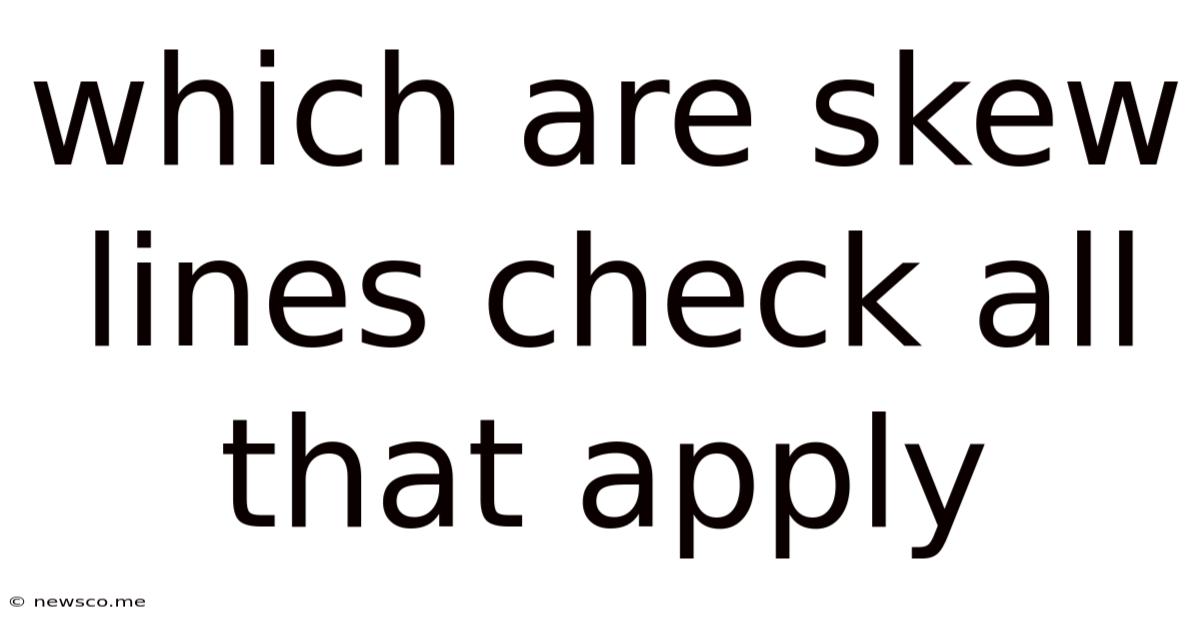Which Are Skew Lines Check All That Apply
News Co
Mar 19, 2025 · 4 min read

Table of Contents
Which Are Skew Lines? Check All That Apply
Understanding skew lines is crucial in geometry and spatial reasoning. This comprehensive guide will delve into the definition of skew lines, explore various scenarios to determine which lines are skew, and provide practical examples to solidify your understanding. We'll also touch upon related concepts to provide a complete picture. By the end, you'll be able to confidently identify skew lines in any given situation.
Defining Skew Lines
Skew lines are lines that do not intersect and are not parallel. This seemingly simple definition encapsulates a key geometric relationship. It's important to note that these lines exist in three-dimensional space. In a two-dimensional plane, two lines will either intersect or be parallel; skew lines are a unique characteristic of three dimensions.
Key Characteristics of Skew Lines:
- Non-Intersecting: They never meet, no matter how far they are extended in either direction.
- Non-Parallel: They do not have the same direction or slope.
- Three-Dimensional: They exist only in three-dimensional space. They cannot be found in a two-dimensional plane.
Think of it like this: imagine two airplanes flying at different altitudes and on different paths. If their paths (represented as lines) never cross and are not parallel, they represent skew lines.
Identifying Skew Lines: A Step-by-Step Approach
Identifying skew lines requires a systematic approach. Let's break down the process:
1. Visualization: The first step is visualizing the lines in three-dimensional space. Often, diagrams or sketches can be invaluable.
2. Check for Intersection: Do the lines intersect at any point? If they do, they are not skew lines.
3. Check for Parallelism: Are the lines parallel? If they are parallel, they are not skew lines. This often involves examining their direction vectors or comparing their slopes (in simpler cases).
4. Confirmation of Skewness: If the lines do not intersect and are not parallel, they are skew lines.
Examples to Illustrate Skew Lines
Let's consider some examples to clarify the concept:
Example 1:
Imagine two lines defined by the following parametric equations:
- Line 1: x = t, y = 2t, z = 3t
- Line 2: x = 1 + s, y = s, z = 2 + s
These lines are skew. If you attempt to solve for t and s such that the x, y, and z coordinates are equal, you'll find there's no solution. This means the lines do not intersect. Further examination of their direction vectors (1, 2, 3) and (1, 1, 1) reveals they are not parallel. Therefore, they are skew lines.
Example 2:
Consider two edges of a cube that do not share a common vertex. These edges represent skew lines. They are not parallel, and they do not intersect.
Example 3:
Imagine a rectangular prism. Consider two edges that are not parallel and do not share a face. These two edges represent skew lines.
Example 4 (Non-Skew Lines):
Consider two lines on a flat table. Even if they appear to be far apart, if they extend infinitely, they will either intersect or be parallel. They cannot be skew lines within the two-dimensional plane of the table's surface.
Distinguishing Skew Lines from Other Line Relationships
It's crucial to differentiate skew lines from other types of line relationships:
- Intersecting Lines: These lines cross at a single point.
- Parallel Lines: These lines never intersect and have the same direction. They maintain a constant distance from each other.
- Coincident Lines: These lines are essentially the same line; they occupy the same space.
Advanced Concepts Related to Skew Lines
Shortest Distance Between Skew Lines
An interesting aspect of skew lines is finding the shortest distance between them. This shortest distance is always along a line that is perpendicular to both skew lines. Calculating this shortest distance often involves vector operations and the concept of cross products.
Applications of Skew Lines
Skew lines find applications in various fields including:
- Computer Graphics: Representing and manipulating three-dimensional objects.
- Robotics: Planning paths for robots and robotic arms.
- Engineering: Designing and analyzing structures in three-dimensional space.
- Physics: Describing the motion of objects in three dimensions.
Practical Exercises to Test Your Understanding
Here are some exercises to reinforce your understanding of skew lines:
-
Identify the Skew Lines: Examine a picture of a three-dimensional object (like a rectangular prism or a cube). Identify several pairs of lines and determine which are skew. Explain your reasoning for each pair.
-
Parametric Equations: Given two sets of parametric equations representing lines in three-dimensional space, determine whether the lines are skew, intersecting, or parallel. Show your work.
-
Geometric Visualization: Imagine different scenarios involving lines in three-dimensional space. Sketch the lines and decide whether they are skew.
Conclusion
Understanding skew lines is fundamental to grasping three-dimensional geometry. By systematically examining lines for intersection and parallelism, you can accurately identify skew lines. Remember, skew lines are non-intersecting and non-parallel lines that exist solely in three-dimensional space. This concept has practical applications in various fields, making it an important topic to master. With practice and visualization, identifying skew lines will become intuitive. The examples and exercises provided here should help solidify your understanding and enable you to confidently tackle problems involving skew lines. Remember to always visualize the lines in 3D space to accurately determine their relationship.
Latest Posts
Related Post
Thank you for visiting our website which covers about Which Are Skew Lines Check All That Apply . We hope the information provided has been useful to you. Feel free to contact us if you have any questions or need further assistance. See you next time and don't miss to bookmark.